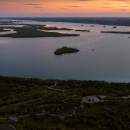Laws and Regulations
Refuges are special places where wildlife comes first. All activities allowed on refuges must be evaluated to make sure each activity will not conflict with the reason the refuge was founded. The refuge system has special regulations about what you can do. You can find these regulations in the 50 Code of Federal Regulations - Subchapter C.
- Plum Island - open for hiking and wildlife observation Memorial Day weekend through Labor Day weekend. Daylight hours only. Overnight docking prohibited. Plum Island coordinates: 85 56' 52.073"W 45 18' 46.55"N.
- Hog Island - closed to all public use to protect colonial nesting birds
- Pilot Island - closed to all public use to protect colonial nesting birds
- St. Martin Island - Closed to all public use for habitat and historic resource protection, and public safety
- Detroit Island Unit - 148 acres of Detroit Island is open for public access including deer hunting. Remainder of island is privately owned. Daylight hours only for the general public; hunting season and hours as outlined within the Wisconsin Department of Natural Resources hunting regulations. The parcel is located on the west shoreline at coordinates: N 45° 18’ 17.7” W 086° 54’ 11.6”.
- Rocky Island - closed to all public use to protect colonial nesting birds

